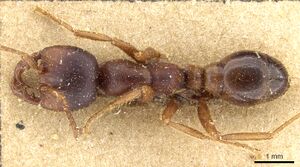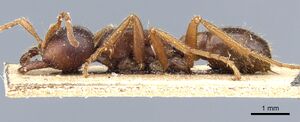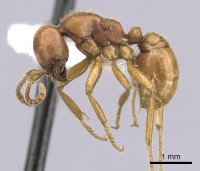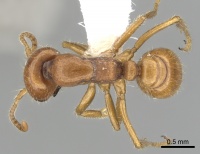Cheliomyrmex andicola
| Cheliomyrmex andicola | |
|---|---|

| |
| Scientific classification | |
| Kingdom: | Animalia |
| Phylum: | Arthropoda |
| Class: | Insecta |
| Order: | Hymenoptera |
| Family: | Formicidae |
| Subfamily: | Dorylinae |
| Tribe: | Cheliomyrmecini |
| Genus: | Cheliomyrmex |
| Species: | C. andicola |
| Binomial name | |
| Cheliomyrmex andicola Emery, 1894 | |
| Synonyms | |
| |
O'Donnell et al. (2005) described foraging and predation by rarely observed hypogaeic army ants in the genus Cheliomyrmex. Unlike other army ants, C. andicola workers use their sting during prey capture. The workers’ unusual mandibles and potent stings may be adapted for piercing and gripping the integument of non-arthropod prey animals, and for rapidly subduing large-bodied prey. They prey on large-bodied ground dwelling invertebrates and, possibly, on vertebrates.
Photo Gallery
Identification
Distribution
Latitudinal Distribution Pattern
Latitudinal Range: 2.625555556° to -4.1°.
| North Temperate |
North Subtropical |
Tropical | South Subtropical |
South Temperate |
- Source: AntMaps
Distribution based on Regional Taxon Lists
Neotropical Region: Brazil, Colombia, Peru (type locality).
Distribution based on AntMaps
Distribution based on AntWeb specimens
Check data from AntWeb
Countries Occupied
| Number of countries occupied by this species based on AntWiki Regional Taxon Lists. In general, fewer countries occupied indicates a narrower range, while more countries indicates a more widespread species. |

|
Estimated Abundance
| Relative abundance based on number of AntMaps records per species (this species within the purple bar). Fewer records (to the left) indicates a less abundant/encountered species while more records (to the right) indicates more abundant/encountered species. |

|
Biology
O'Donnell et al. (2005) - A subterranean column of C. andicola workers erupted from the soil in pursuit of a fleeing giant earthworm. Several hundred ant workers ran over the leaf litter in the direction taken by the worm. Five C. andicola workers mounted the worm and were biting and apparently stinging its body. After the worm crawled for a distance of 3 m down slope from where it exited the soil, its body contracted from over 40 cm in length to approximately 20 cm in length, and abruptly stopped moving. We assumed that the worm was either paralyzed or dead. Thus Cheliomyrmex workers can actively pursue and subdue large-bodied, fast moving prey. We hypothesize that the mandibular morphology in Cheliomyrmex is an adaptation for the successful capture of large-bodied prey.
Castes
Images from AntWeb
   
| |
| Syntype of Cheliomyrmex nortoni andicola. Worker (major/soldier). Specimen code casent0903718. Photographer Z. Lieberman, uploaded by California Academy of Sciences. | Owned by MSNG, Genoa, Italy. |
Nomenclature
The following information is derived from Barry Bolton's Online Catalogue of the Ants of the World.
- andicola. Cheliomyrmex nortoni subp. andicola Emery, 1894c: 185 (s.) PERU.
- Type-material: holotype major worker.
- Type-locality: Peru: Panamarca (K.R. Jelski).
- Type-depository: MSNG.
- Forel, 1914e: 10 (w.).
- Subspecies of nortoni: Emery, 1910b: 17.
- Status as species: Forel, 1914e: 10; Wheeler, W.M. 1921d: 325; Borgmeier, 1936: 65; Borgmeier, 1955: 71 (redescription); Kempf, 1972a: 76; Kempf, 1975c: 371; Watkins, 1976: 6 (in key); Brandão, 1991: 337; Bolton, 1995b: 145; Bezděčková, et al. 2015: 109; Palacio, 2019: 588.
- Senior synonym of ursinum Kempf, 1975c: 372; Brandão, 1991: 337; Bolton, 1995b: 145.
- Distribution: Brazil, Colombia, Ecuador, Panama, Peru.
- ursinum. Eciton morosum subsp. ursinum Emery, 1901d: 52 (m.) BRAZIL (no state data).
- Type-material: holotype male.
- Type-locality: Brazil: (no further data) (ex coll. André).
- Type-depository: MNHN.
- Combination in Cheliomyrmex: Wheeler, W.M. 1921d: 324.
- Subspecies of morosus: Emery, 1910b: 23; Borgmeier, 1923: 44; Bolton, 1995b: 145.
- Status as species: Wheeler, W.M. 1921d: 324; Borgmeier, 1955: 76; Kempf, 1972a: 77; Watkins, 1976: 7 (in key).
- Junior synonym of andicola: Kempf, 1975c: 372; Brandão, 1991: 337.
Description
References
- Borgmeier, T. 1955. Die Wanderameisen der neotropischen Region. Stud. Entomol. 3: 1-720 (page 71, see also)
- Emery, C. 1894d. Studi sulle formiche della fauna neotropica. VI-XVI. Bull. Soc. Entomol. Ital. 26: 137-241 (page 185, soldier described)
- Forel, A. 1914e. Quelques fourmis de Colombie. Pp. 9-14 in: Fuhrmann, O., Mayor, E. Voyage d'exploration scientifique en Colombie. Mém. Soc. Neuchâtel. Sci. Nat. 5(2):1-1090. (page 10, worker described)
- Forel, A. 1914e. Quelques fourmis de Colombie. Pp. 9-14 in: Fuhrmann, O., Mayor, E. Voyage d'exploration scientifique en Colombie. Mém. Soc. Neuchâtel. Sci. Nat. 5(2):1-1090. (page 10, Raised to species)
- Kempf, W. W. 1975c. Miscellaneous studies on neotropical ants. VI. (Hymenoptera, Formicidae). Stud. Entomol. 18: 341-380 (page 372, Senior synonym of ursinum)
- O'Donnell, S., Kaspari, M. & Lattke, J. 2005. Extraordinary Predation by the Neotropical Army Ant Cheliomyrmex andicola: Implications for the Evolution of the Army Ant Syndrome. Biotropica 37(4): 706–709.
References based on Global Ant Biodiversity Informatics
- Borgmeier T. 1955. Die Wanderameisen der neotropischen Region. Studia Entomologica 3: 1-720.
- Borowiec M. L. 2016. Generic revision of the ant subfamily Dorylinae (Hymenoptera, Formicidae). ZooKeys 608: 1–280.
- Emery C. 1894. Studi sulle formiche della fauna neotropica. VI-XVI. Bullettino della Società Entomologica Italiana 26: 137-241.
- Emery C. 1910. Hymenoptera. Fam. Formicidae. Subfam. Dorylinae. Genera Insectorum 102: 1-34.
- Escalante Gutiérrez J. A. 1993. Especies de hormigas conocidas del Perú (Hymenoptera: Formicidae). Revista Peruana de Entomología 34:1-13.
- Estrada M., C. and F. Fernandez. 1999. Diversidad de hormigas (Hymenoptera: Formicidae) en un gradiente sucesional del bosque nublado (Nariño, Colombia). Revista de Biología Tropical 47(1-2).
- Fernández, F. and S. Sendoya. 2004. Lista de las hormigas neotropicales. Biota Colombiana Volume 5, Number 1.
- Kempf W. W. 1975. Miscellaneous studies on neotropical ants. VI. (Hymenoptera, Formicidae). Studia Entomologica 18: 341-380.
- Kempf, W.W. 1972. Catalago abreviado das formigas da regiao Neotropical (Hym. Formicidae) Studia Entomologica 15(1-4).
- O'Donnell S., J. Lattke, S. Powell, and M. Kaspari. 2007. Army ants in four forests: geographic variation in raid rates and species composition. Journal of Animal Ecology 76: 580-589.
- Palacio E. 1999. Hormigas legionarias (Hymenoptera: Formicidae: Ecitoninae) de Colombia. Pp. 117-189 in: Amat-G., G.; Andrade-C., M. G.; Fernández, F. (eds.) 1999. Insectos de Colombia. Volumen II. Bogotá: Academia Colombiana de Ciencias Exactas, Físicas y Naturales, 433 pp.
- Watkins J. F., II 1976. The identification and distribution of New World army ants (Dorylinae: Formicidae). Waco, Texas: Baylor University Press, 102 pp


